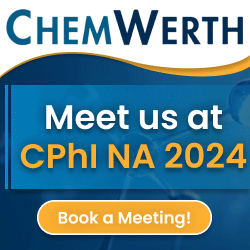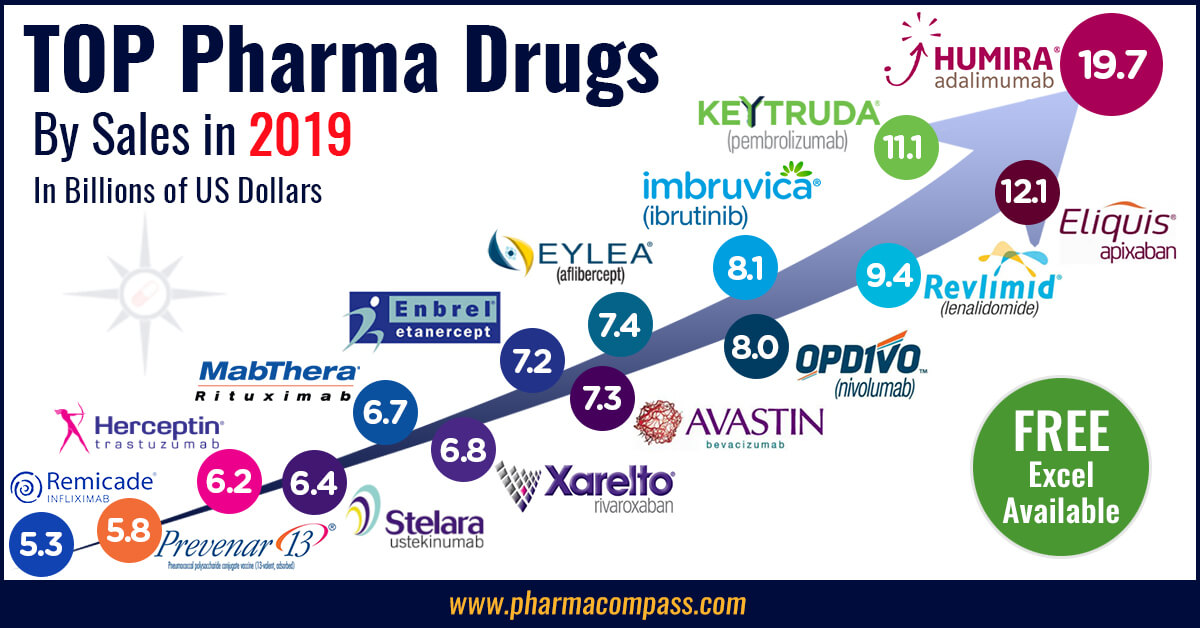Acquisitions and spin-offs dominated headlines in 2019 and the tone was set very early with Bristol-Myers Squibb acquiring
New Jersey-based cancer drug company Celgene in a US$ 74 billion deal announced on
January 3, 2019. After factoring
in debt, the deal value ballooned to about US$ 95 billion, which according
to data compiled by Refinitiv, made it the largest healthcare deal on
record.
In the summer, AbbVie Inc,
which sells the world’s best-selling drug Humira, announced its acquisition of Allergan Plc, known for Botox and other cosmetic
treatments, for US$ 63 billion. While the companies are still awaiting
regulatory approval for their deal, with US$ 49 billion in combined 2019
revenues, the merged entity would rank amongst the biggest in the industry.
View Our Interactive Dashboard on Top drugs by sales in 2019 (Free Excel Available)
The big five by pharmaceutical sales — Pfizer,
Roche, J&J, Novartis and Merck
Pfizer
continued
to lead companies by pharmaceutical sales by reporting annual 2019 revenues of
US$ 51.8 billion, a decrease of US$ 1.9 billion, or 4 percent, compared to
2018. The decline was primarily attributed to the loss of exclusivity of Lyrica in 2019,
which witnessed its sales drop from US$ 5 billion in 2018 to US$ 3.3 billion in
2019.
In 2018, Pfizer’s then incoming CEO Albert Bourla had mentioned that the company did not see the need for any large-scale M&A activity as Pfizer had “the best pipeline” in its history, which needed the company to focus on deploying its capital to keep its pipeline flowing and execute on its drug launches.
Bourla stayed true to his word and barring the acquisition of Array Biopharma for US$ 11.4 billion and a spin-off to merge Upjohn, Pfizer’s off-patent branded and generic established medicines business with
Mylan, there weren’t any other big ticket deals which were announced.
The
Upjohn-Mylan merged entity will be called Viatris and is expected to have 2020
revenues between US$ 19 and US$ 20 billion
and could outpace Teva to
become the largest generic company in the world, in term of revenues.
Novartis, which had
followed Pfizer with the second largest revenues in the pharmaceutical industry
in 2018, reported its first full year earnings after spinning off its Alcon eye
care devices business division that
had US$ 7.15 billion in 2018 sales.
In 2019,
Novartis slipped two spots in the ranking after reporting total sales of US$
47.4 billion and its CEO Vas Narasimhan continued his deal-making spree by buying New
Jersey-headquartered The Medicines Company (MedCo) for US$ 9.7
billion to acquire a late-stage cholesterol-lowering
therapy named inclisiran.
As Takeda Pharmaceutical Co was
busy in 2019 on working to reduce its debt burden incurred due to its US$ 62
billion purchase of Shire Plc, which was announced in 2018, Novartis also purchased
the eye-disease medicine, Xiidra, from the Japanese drugmaker for US$ 5.3 billion.
Novartis’ management also spent a considerable part of 2019 dealing with data-integrity concerns which emerged from its 2018 buyout of AveXis, the
gene-therapy maker Novartis had acquired for US$ 8.7 billion.
The deal gave Novartis rights to Zolgensma,
a novel treatment intended for children less than two years of age with the
most severe form of spinal muscular atrophy (SMA). Priced at US$ 2.1 million,
Zolgensma is currently the world’s most expensive drug.
However,
in a shocking announcement, a month after approving the drug, the US Food and
Drug Administration (FDA) issued a press release on
data accuracy issues as the agency was informed by AveXis that
its personnel had manipulated data which
the FDA used to evaluate product comparability and nonclinical (animal)
pharmacology as part of the biologics license application (BLA), which was
submitted and reviewed by the FDA.
With US$
50.0 billion (CHF 48.5 billion) in annual pharmaceutical sales, Swiss drugmaker
Roche came in at number two position in 2019
as its sales grew 11 percent driven by
its multiple sclerosis medicine Ocrevus, haemophilia drug Hemlibra and cancer medicines Tecentriq and Perjeta.
Roche’s newly introduced medicines generated US$ 5.53 billion (CHF 5.4 billion) in growth, helping offset the impact of the competition from biosimilars for its three best-selling drugs MabThera/Rituxan, Herceptin and Avastin.
In late 2019, after months of increased
antitrust scrutiny, Roche completed
its US$ 5.1 billion acquisition of Spark Therapeutics to strengthen its presence in
gene therapy.
Last year, J&J reported almost flat worldwide sales of US$ 82.1 billion. J&J’s pharmaceutical division generated US$ 42.20 billion and its medical devices and consumer health divisions brought in US$ 25.96 billion and US$ 13.89 billion respectively.
Since J&J’s consumer health division sells analgesics, digestive health along with beauty and oral care products, the US$ 5.43 billion in consumer health sales from over-the-counter drugs and women’s health products was only used in our assessment of J&J’s total pharmaceutical revenues. With combined pharmaceutical sales of US$ 47.63 billion, J&J made it to number three on our list.
While the sales of products like Stelara, Darzalex, Imbruvica, Invega Sustenna drove J&J’s pharmaceutical business to grow by 4 percent over 2018, the firm had to contend with generic competition against key revenue contributors Remicade and Zytiga.
US-headquartered Merck, which is known as
MSD (short for Merck Sharp & Dohme) outside the United States and
Canada, is set to significantly move up the rankings next year fueled by its
cancer drug Keytruda, which witnessed a 55
percent increase in sales to US$ 11.1 billion.
Merck reported total revenues of US$ 41.75 billion and also
announced it will spin off its women’s health drugs,
biosimilar drugs and older products to create a new pharmaceutical
company with US$ 6.5 billion in annual revenues.
The firm had anticipated 2020 sales between US$ 48.8 billion and US$ 50.3 billion however this week it announced that the coronavirus pandemic will reduce 2020 sales by more than $2 billion.
View Our Interactive Dashboard on Top drugs by sales in 2019 (Free Excel Available)
Humira holds on to remain world’s best-selling drug
AbbVie’s acquisition of Allergan comes as the firm faces the expiration of patent protection for Humira, which brought in a staggering US$ 19.2 billion in sales last year for
the company. AbbVie has failed to successfully acquire or develop a major new
product to replace the sales generated by its flagship drug.
In 2019, Humira’s US revenues increased 8.6 percent to US$ 14.86 billion while internationally, due
to biosimilar competition, the sales dropped 31.1 percent to US$ 4.30 billion.
Bristol Myers Squibb’s Eliquis, which is also marketed by Pfizer, maintained its number two position
and posted total sales of US$ 12.1 billion, a 23 percent increase over 2018.
While Bristol Myers Squibb’s immunotherapy treatment Opdivo, sold in partnership with Ono in Japan, saw sales increase from US$ 7.57 billion to US$ 8.0 billion, the growth paled in comparison to the US$ 3.9
billion revenue increase of Opdivo’s key immunotherapy competitor Merck’s Keytruda.
Keytruda took the number three spot in drug sales that
previously belonged to Celgene’s Revlimid, which witnessed a sales decline from US$ 9.69 billion to US$ 9.4 billion.
Cancer treatment Imbruvica, which is marketed
by J&J and AbbVie, witnessed a 30 percent increase in sales. With US$ 8.1
billion in 2019 revenues, it took the number five position.
View Our Interactive Dashboard on Top drugs by sales in 2019 (Free Excel Available)
Vaccines – Covid-19 turns competitors into partners
This year has been dominated by the single biggest health emergency in years — the novel coronavirus (Covid-19) pandemic. As drugs continue to fail to meet expectations, vaccine development has received a lot of attention.
GSK reported the highest vaccine sales of all drugmakers with
total sales of US$ 8.4 billion (GBP 7.16 billion), a significant portion of its
total sales of US$ 41.8 billion (GBP 33.754 billion).
US-based Merck’s vaccine division also reported a significant increase in sales to US$ 8.0 billion and in 2019 received FDA and EU approval to market its Ebola vaccine Ervebo.
This is the first FDA-authorized vaccine against the deadly virus which causes
hemorrhagic fever and spreads from person to person through direct contact with
body fluids.
Pfizer and Sanofi also reported an increase in their vaccine sales to US$ 6.4
billion and US$ 6.2 billion respectively and the Covid-19 pandemic has recently
pushed drugmakers to move faster than ever before and has also converted
competitors into partners.
In a rare move, drug behemoths — Sanofi and GlaxoSmithKline (GSK) —joined hands to develop a vaccine for the novel coronavirus.
The two companies plan to start human trials
in the second half of this year, and if things go right, they will file
for potential approvals by the second half of 2021.
View Our Interactive Dashboard on Top drugs by sales in 2019 (Free Excel Available)
Our view
Covid-19 has brought the world economy to a grinding halt and shifted the global attention to the pharmaceutical industry’s capability to deliver solutions to address this pandemic.
Our compilation shows that vaccines and drugs
for infectious diseases currently form a tiny fraction of the total sales of
pharmaceutical companies and few drugs against infectious diseases rank high on
the sales list.
This could well explain the limited range of
options currently available to fight Covid-19. With the pandemic currently infecting
over 3 million people spread across more than 200 countries, we can safely
conclude that the scenario in 2020 will change substantially. And so should our
compilation of top drugs for the year.
View Our Interactive Dashboard on Top drugs by sales in 2019 (Free Excel Available)
Impressions: 54754
In October
2016, the US Food and Drug Administration (FDA) inspected a facility in India
belonging to Granules India that manufactures pharmaceutical
formulation intermediates (PFIs) and finished dosage forms (FDFs). The FDA had
no observations.
Three months later, Portugal’s health authority — INFARMED — inspected the same site and detected non-conformities in good manufacturing practices (GMPs).
According to an alert published
on the INFARMED website, the observations were related to granulation and
primary packaging of tablets in batches of drugs related to paracetamol and metformin supplied by Granules to Mylan, Bluepharma and Sandoz. The agency recommended the
suspension and recall of certain batches from the market in Portugal.
Last week, based on “General GMP Observations” of “regulatory partner(s)”, Health Canada placed Granules India’s facility located in Gagillapur (near Hyderabad) on its inspection tracker. Health Canada’s inspection tracker provides updates on the actions the regulator is undertaking to assess and manage potential risks arising from inspections of drug manufacturing facilities.
According to
Granules, their facility in Gagillapur contributes over 50 percent to their revenues and “has the world’s largest PFI capacity along with an industry-leading batch size of six tons. In addition, the Gagillapur facility has one of the largest single-site finished dosage capacities in the world for their respective products.”
In a recent
interview, C. Krishna Prasad, managing director of Granules India, said there
were no issues related to data integrity and INFARMED is scheduled to re-inspect
the Gagillapur facility this week.
Data
integrity concerns at ACS Dobfar’s
Italian facility
The FDA’s April 2016 inspection of ACS Dobfar’s
operations in Brazil — Antibioticos do Brasil (ABL) — led to the issuance of a warning letter in December. Among other observations, the FDA investigators found that the filling zone for sterile injectable product was not sufficiently robust. Therefore, it didn’t protect the drugs being manufactured there (such as during the times when operators entered the final filling area).
Almost immediately after the warning letter was issued, an inspection of the same facility by the Italian Regulatory Agency (AIFA) found it not-compliant for the manufacture of the active ingredient — Cephalexin Sodium Sterile. AIFA also recommended the
suspension of the Certificate of Suitability issued for ceftazidime pentahydrate with sodium carbonate for injection.
The inspectors
found ABL failed to ensure a good level of maintenance and cleaning of the
final crystallization area and there was a poor level of training, low
knowledge and awareness of good manufacturing practices (GMP) along with lack of supervisory
control.
The
non-compliance report also mentions that some non-authorized and fraudulent
activities were stopped before inspectors entered certain manufacturing areas.
Fraudulent activities were not limited to Brazil, as ACS Dobfar’s Italian drug manufacturing facility — FACTA Farmaceutici SpA — had FDA investigators uncover data-integrity violations during a January 2016 inspection.
The warning
letter issued to FACTA mentions that for multiple lots of sterile drug product,
where the original data showed failing results, the data reportedly showed
passing results.
The company was found storing original data in an “unofficial” and uncontrolled electronic spreadsheet on a shared computer network drive. The analyst told investigators that original data was first recorded in the “unofficial” spreadsheet and later transcribed to an “official” form.
Investigators also observed many
copies of uncontrolled blank and partially-completed cGMP forms and also
documented that employees at FACTA used paper shredders to destroy critical
laboratory and production records.
It is worth mentioning that FACTA’s EU GMP certification was renewed by the Italian regulators after an inspection that was conducted at the same time as the FDA inspection.
Data integrity concerns confirmed at Divi’s Laboratories in India
Divi’s Laboratories’ Unit-II situated in Visakhapatnam, Andhra Pradesh — one of the biggest manufacturing facilities for the major producer of active pharmaceutical ingredients (APIs) — was inspected by the US FDA from November 29 to December 6, 2016.
The regulators
issued a Form 483 with five observations.
While data integrity concerns had been widely reported in news media,
Health Canada confirmed the violations by placing the company on its inspection
tracker last week.
FDA’s warning letter comes to haunt Dr. Reddy’s
South Korean biotech firm — Mezzion Inc — filed a suit for damages
against Dr. Reddy’s in New Jersey state court alleging that it hid “significant deficiencies in its FDA cGMP practices” and misrepresented its compliance.
Mezzion has stated in its suit that “Dr. Reddy's repeatedly represented to Mezzion that it was compliant with FDA regulations” whereas the FDA issued a warning letter to Dr. Reddy's.
During an FDA inspection at Dr. Reddy's facilities in India, the FDA identified numerous data integrity violations and also uncovered a previously unknown and uncontrolled “Custom QC laboratory” (CQC), which engaged in a “practice of substituting repeat tests after failing results.”
Mezzion further states: “Dr. Reddy’s misconduct was the sole reason given by the FDA to deny approval of Mezzion’s new drug application (NDA) for udenafil for the treatment of erectile dysfunction (ED)”. As a result, Mezzion has incurred delays and was forced to seek new manufacturers and suppliers for udenafil and the udenafil finished product, in order to resubmit its udenafil New Drug Application (NDA) to the FDA for approval.
FDA’s warning letters to
manufacturers in UK and India
Porton Biopharma, UK: A
warning letter was
issued to the UK-based Porton Biopharma by the US FDA for manufacturing violations related to Erwinaze (asparaginase Erwinia chrysanthemi) — an orphan biologic which was developed by Porton and licensed to Jazz Pharmaceuticals.
According to the warning letter, the FDA had previously performed an inspection of Porton’s facility in January 2015 and found similar concerns. The inspection between March 7 and 18, 2016,
which triggered the warning letter,
had FDA investigators observe continued deficiencies, including metal particles
which penetrated a few batches of Erwinaze, another batch containing paper or
cardboard fibers and a possible microbial contamination.
While Porton
believed that vial stoppers were the source of the metal scraps, the FDA
investigators were not convinced.
Erwinaze
generated around US $ 43 million in the third quarter for Jazz Pharmaceuticals, accounting for more than 10 percent of the company’s revenues.
CTX Life Sciences, India: The FDA issued a warning letter to CTX Life Sciences in India after making observations of rust, insects, damaged interiors, and/or drug residues in pieces of manufacturing equipment identified as “clean”.
Investigators also found that the API were released without testing because the necessary laboratory equipment was out of order. While the company had decided to release batches “on conditional basis and as soon as UV maintenance issue rectified analysis shall be performed” the investigators could find no trace of the testing.
Our view
Last week, in
our compliance round up, we had reported the shredding of documents at Hetero Labs in India. And this week, similar issues have surfaced in
Italy.
It’s clear that corrupt practices of data integrity are spreading across the industry and are no longer confined to a region.
At the same time, while both European and US regulators reached a similar outcome on the compliance status of Antibioticos do Brasil, the divergent views at Granules India and FACTA Farmaceutici indicate the urgency for regulators to establish a consistent global evaluation standard for pharmaceutical manufacturing.
Impressions: 9420
This week’s Phispers takes you through pharmaceutical news from across the globe – from Joe Biden’s computer aided cancer moonshot to AbbVie’s second largest venture capital buyout in history and a lot more. After GMP troubles,
migraine patch gives Teva a fresh headacheLast week, Phispers carried news on Teva’s facility
in Hungary, which was placed on the US Food and Drug Administration’s import alert list. The FDA inspection had found the plant not conforming to the current good manufacturing practices (GMPs). This week, there is more bad news for Teva Pharmaceuticals. The company had bought NuPathe in early 2014 for about US $ 114 million. Through this acquisition, Teva had got its hands on the only migraine patch approved in the US – known as Zecuity. The patch first hit the market in September 2015. However, in less than a year of its launch, Teva's Zecuity
is under
the FDA radar for concerns over “serious” adverse events including burning and scarring. Moreover, a large number of users have also reported other problems, such as severe redness, pain, skin discoloration, blistering and cracked skin, the FDA said. Britain’s Patel brothers do a Martin Shkreli on drugs needed by NHSWhile America’s Martin Shkreli faced additional
criminal charges this week of conspiracy to commit securities fraud during
his tenure as the CEO of Retrophine (2012 to 2014), Britain saw its own avatars of Shkreli. Millionaire brothers Vijay and Bhikhu Patel, also known as ‘Bollygarchs’ – have been accused of being part of a group of businesses that hike up prices of common drugs needed by the National Health Service (NHS), the publically-funded healthcare system for England. The Patel brothers have allegedly exploited a loophole in NHS’ pricing system. Today the four businesses, including two with past and present links to the Patel siblings, have allegedly hiked the price of common drugs by up to 12,500 per cent. The unreasonably high prices have cost the NHS an additional £ 262 million (US $ 381 million) a year. This sum has conveniently gone into the pockets of the Patel siblings and their associates. Cancer treatment
least affordable in India and ChinaWhile we all know that Americans pay the highest prices in
the world for cancer drugs, a new study highlights how cancer treatments are
least affordable in lower income countries. The study – presented at the annual meeting of the American Society of Clinical Oncology in Chicago – looked at the prices of cancer drugs in seven countries, while not taking into account discounts or rebates. The lowest drug prices were found in India and South Africa.
But then, when adjusted for the cost of living, cancer drugs appeared to be
least affordable in India and China. The study only strengthens the case for politicians,
healthcare providers, doctors, insurers and patients, who have been opposing
the high prices commanded by modern cancer drugs. Drug companies justify the
high prices, citing the high cost of drug research and the need to make profits
to continue spending on research and drug development. Sun Pharma sells two
US facilities to Frontida BioPharmaSun
Pharmaceuticals – India’s largest drug maker – is
selling off two oral solid dosage manufacturing plants in the US to
Frontida BioPharm Inc. (a part of Frontage
Pharma). The sell-off is part of Sun Pharma’s plans to consolidate its manufacturing facilities in the US. The plants are situated in Philadelphia and Illinois. Sun Pharma earns about half of its total revenues from the
US. And this is the drug maker’s second divestment in the US in the last six months. In December, it had divested
its manufacturing plant in Ohio to Nostrum
Laboratories. The company is also looking to sell facilities and business
units from the Ranbaxy
portfolio. In September 2015, it put
a plant in Ireland on the block to optimize its overall manufacturing base and
also sold
the central nervous system business (of erstwhile Ranbaxy) to Strides
Shasun for INR 1.65 billion (US $ 24.8 million). China’s Fosun leads the race for India’s Gland Pharma with US $ 1.27 billion bidLast week, Hong Kong-listed Shanghai
Fosun (Fosun Pharma) revised its offer to buy KKR-backed Gland
Pharma to US
$ 1.27 billion, the highest so far.
American healthcare company Baxter
International and private equity fund Advent made their offers in May. The frontrunner for Gland Pharma, until recently, was Baxter
with its bid at US $1.1 billion, a news report said. Fosun Pharma is part of Chinese billionaire Guo Guangchang’s extensive business empire. Fosun is believed to have completed its due diligence on Gland Pharma sometime last week. Final negotiations are planned for next week, and we hope to hear a formal announcement on Gland Pharma sometime in the third week of June. Joe Biden launches
open-access cancer database as part of the Cancer Moonshot InitiativeOn Monday, American Vice President Joe Biden announced the
launch of an open-access
cancer database that will allow researchers to better understand cancer and
develop more effective treatments. This first of its kind database, a part of the National
Cancer Moonshot initiative, known as the Genomic Data Commons (GDC), contains
the raw genomic and clinical data of 12,000 patients. The database has detailed
analyses of the molecular makeup of cancers and information on which treatments
were used and how patients responded. The database will encourage the much-needed collaboration
among scientists in different disciplines to research important aspects of
cancer and find new ways to help patients, Biden told doctors. Medicines containing
aspirin can cause stomach bleeding, warns FDAAspirin-containing
medicines to treat heartburn, sour stomach, acid indigestion, or upset stomach
can cause stomach or
intestinal bleeding, warns the USFDA. Since aspirin thins the blood, FDA believes the aspirin in
these combination medicines is contributing to major bleeding events. The
instances of bleeding, however, are rare. In 2009, FDA had issued a warning about serious stomach bleeding risk with aspirin and other non-steroidal anti-inflammatory drugs (NSAIDs). When FDA reviewed its Adverse Event Reporting System database, it found eight new cases of serious bleeding caused by aspirin-containing antacid products since the 2009 warning. Some of those patients required blood transfusion. “Take a close look at the Drug Facts label, and if the product has aspirin, consider choosing something else for your stomach symptoms,” an FDA official said. AbbVie blockbuster
buyout disappoints investorsOn Sunday, AbbVie began
explaining why it paid a whopping US $ 5.8 billion upfront – with US $ 4 billion reserved for milestones – for biotechnology company Stemcentrx and its cancer drug Rova-T (rovalpituzumab tesirine). AbbVie’s acquisition of Stemcentrx is the second largest venture-capital backed startup acquisition in history, after Facebook paid
$19 billion to buyout WhatsApp. However, the first set of data provided by AbbVie disappointed investors. Although the drug’s performance against small cell lung cancer, a disease which has not seen a change in survival rates since the 1970s, showed that 68 percent of the patients achieved a clinical benefit, the expectations from the investor community were much higher.Rova-T targets a protein called “DLL3 that is normally found only deep inside cells. But DLL3 winds up all over the outside of some types of cancer cells. Rova T pairs an antibody, which detects DLL3, with a powerful chemotherapy that kills the cells the antibody detects.” Major fire at Nectar
Lifesciences plant in Punjab, IndiaOn June 3, a fire
broke out in Unit-II of Nectar
Lifesciences Limited, a leading pharmaceutical company, in India. Huge
stocks of pharmaceutical products, chemicals and goods were destroyed in the
fire. However, no loss of human life was reported. The fire broke out around 9.15 pm at the solvent recovery
plant and spread to the other sections of the unit and caused damage. Fire tenders
had to be arranged from neighboring cities to douse the flames.Nectar Lifesciences is a manufacturer of both active
pharmaceutical ingredients and finished formulations with a focus on
antibiotics like Cefixime, Cefpodoxime
Proxetil, Ceftazidime
etc.
Impressions: 2092
Each year,
the US Food and Drug Administration (FDA) approve hundreds
of new medications. A small subset of approvals, classified as novel drugs, are considered to
be truly innovative products that often help advance clinical care.
In 2015, the
FDA approved 45 novel drugs, an all-time record high. PharmaCompass has compiled a list of novel drugs approved by the FDA in 2015.The FDA also approved new dosage forms of existing products in the market (email us if you would like a copy), like the 3D printed version of anti-epilepsy drug, Spritam (Levetiracetam).
This week, PharmaCompass focuses on the new dosage
forms of existing drugs that got approved last year.
Modified blockbusters
Improving the delivery form of a blockbuster drug is something that not only helps patients but often successfully extends the patent life of the cash-generating drugs for Big Pharma. Here are some blockbuster drugs that saw their modified versions being launched in 2015:
Jadenu (deferasirox): With
almost a billion dollars in revenues in 2015, Exjade (deferasirox) was approved in 2005 as a
tablet for use in a suspension. Novartis, the innovator,
got approval in March 2015
for Jadenu, a once-daily oral tablet. Jadenu (deferasirox), a new formulation
of Exjade, is the only once-daily oral tablet for iron chelation. Jadenu has
simplified daily treatment administration for patients with chronic iron
overload.
Nexium
24HR (esomeprazole magnesium): Also
known as the Purple Pill, Nexium – Astra
Zeneca’s blockbuster drug for acid reflux that generated annual sales in America of more than US $ 3 billion – went generic in 2015. In order to extend Nexium’s market, Pfizer and AstraZeneca came together to promote an over-the-counter (OTC) version of Nexium. A capsule version of OTC Nexium was approved in 2014 and is known as
Nexium 24HR. Last year, the FDA granted approval to the tablet form of the
drug.
Iressa
(gefitinib): AstraZeneca re-introduced Iressa in
the US market in 2015. The
FDA had approved Gefitinib in May 2003 for non-small cell lung cancer. Approved
as a third-line therapy, in 2010 the FDA requested AstraZeneca to voluntarily withdraw Iressa tablets
from the market, as post-marketing studies had failed
to verify and confirm clinical benefit. Iressa (gefitinib) is now back in the US as a first-line therapy for a type of lung cancer. However, the patent protection is limited – only one listed patent in the Orange Book which expires next year, and five US Drug Master Files already submitted.
Onivyde (irinotecan): Liposomal formulation of anti-cancer
drugs have been in vogue for some time. Merrimack Pharmaceuticals got its novel encapsulation of Irinotecan in a liposomal formulation approved for the
treatment of patients with metastatic pancreatic cancer, sold under the brand
name Onivyde.
Vivlodex (meloxicam): In October 2015, the FDA approved 5 mg and 10 mg (administered once daily) doses of Vivlodex™ (meloxicam) capsules, a nonsteroidal anti-inflammatory drug (NSAID) used for the management of osteoarthritis pain. The previously approved doses for meloxicam capsules were 7.5mg and 15mg. Vivlodex uses a proprietary SoluMatrix Fine Particle Technology™, which contains meloxicam as submicron particles that are approximately 10 times smaller than their original size. The reduction in particle size provides an increased surface area, leading to faster dissolution.
Kalydeco (ivacaftor): A cystic fibrosis drug from Vertex Pharmaceuticals – Kalydeco – has been making headlines
because of its high price (more than US $ 300,000 a year). Price concerns
aside, 2015 saw the launch of a pediatric version of the drug as a ‘weight-based oral granule formulation of Kalydeco that can be mixed in soft foods or liquids’.
Extended release versions
Many of
the approvals granted by the FDA last year were to extended release
formulations (a pill formulated so that the drug is released slowly) of
existing drugs.
Kremers Urban’s
extended release version of Methylphenidate
capsules made headlines last year because of a reclassification of the drug by
the FDA. Under the new classification rating, methylphenidate hydrochloride extended-release tablets can be prescribed but may
not be automatically substituted for J&J’s reference drug Concerta (methylphenidate hydrochloride). Kremers Urban was almost sold last year. But due to this reclassification, investors aborted their US $ 1.53 billion buyout. Kremers Urban was later acquired by Lannett Company Inc.
In
addition, extended-release versions of Aspirin, Carbidopa/Levodopa, Paliperidone Palmitate, Tacrolimus
and Morphine Sulphate also received green signals for a market launch.
First generic opportunities
Last year, PharmaCompass
shared the names of some drugs which had no generic competition and were also
not protected by patents. (Read: “Litigation Free, first generic opportunities list”).
Deferiprone (a drug that chelates iron and is
used to treat iron overload in thalassemia major) met the criteria. But it still
has no generic competitor and is now available as a new dosage form.
Amedra Pharmaceuticals, now owned by Impax Laboratories, has enjoyed the rights to sell Albendazole tablets for almost two decades
without generic competition in the US. Albendazole is a medication used for the
treatment of a variety of parasitic worm infestations. In 2015, patients were
provided access to chewable tablets of Albendazole.
New combinations at work
The FDA also approved
multiple combination drugs where the individual active ingredients had been brought
to market previously.
Most of the combination drugs
approved belong to major pharma players like Novartis, Novo Nordisk, Bristol Myers etc.
Boehringer’s diabetes treatments – Jardiance (empagliflozin) – approved in 2014 and
Tradjenta (linagliptin) approved in 2011, were
combined and the combination drug product Glyxambi was approved in 2015. Another
combination of empagliflozin, with metformin – Synjardy – was also approved in August last
year.
Lesser known companies also
got combination drugs approved. UK-based
development company Vernalis got approval for its cold-cough treatment, Tuzistra XR – an extended release suspension of codeine polistirex and chlorpheniramine
polistirex.
Similarly, US-based biopharmaceutical startup, Spriaso LLC, also
working in the cold and cough therapeutic area, got an extended release tablet
containing codeine phosphate and chlorpheniramine maleate approved.
Symplmed, a company which is
developing various forms of Perindopril, got approval for Prestalia (a
combination of perindopril arginine and amlodipine besylate) for the
treatment of hypertension.
Our view
Each year, the FDA approves several
pharmaceutical drugs in order to improve patient care; and often versions of
these drugs are marketed and distributed across the globe.
PharmaCompass’ list of drugs approved in 2015 is now available – just email us for your copy.
Accelerate your drug development
PharmaCompass has also launched
the Drug Development Assistance tool on its platform.
Simply search for the drug or the active ingredient of your interest, click on the Drug Development icon on the left menu bar and you can see the inactive ingredients used to formulate
the various drug products approved in the United States.
Impressions: 5419
















